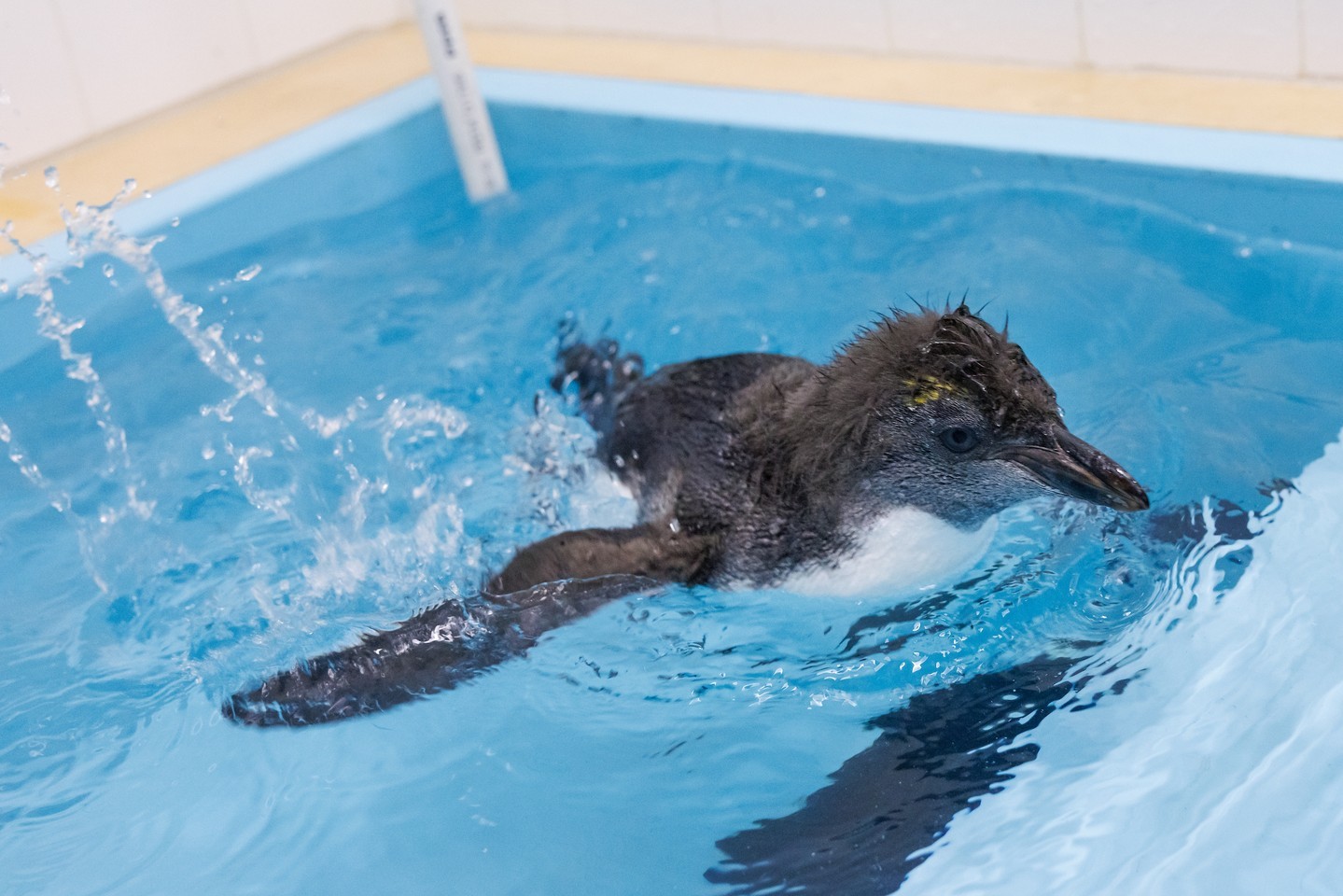- Developmental Milestones of the Macaroni Penguin Chick
- Physical Changes and Adaptations
- The Importance of the Swim Test
- Conservation Efforts and the Role of Zoos
- Educational and Zoological Insights of Penguin Chicks
The Macaroni Penguin chick is now more than 60 days old, marking significant milestones in its journey toward adulthood. At this stage, the chick has undergone notable physical and behavioral changes, earning it new responsibilities and challenges.
Developmental Milestones of the Macaroni Penguin Chick
The first 60 days of a Macaroni Penguin chick’s life are crucial. Initially, the chick is heavily dependent on its parents for warmth and food. Parent Macaroni Penguins alternate between foraging trips and guarding the nest. The most intensive care period involves continuous feeding and protection from potential predators. Around the 30-day mark, a noticeable shift occurs; the chick begins to explore its immediate surroundings and show early signs of independence.
By 60 days, the chick’s exploration radius expands, and it makes frequent ventures outside the nest. This period is essential for developing social skills, as the chick interacts with others in the colony. It participates in early communal behaviors, a precursor to its integration into the adult community. These behavioral milestones are fundamental in preparing the chick for physically demanding activities, such as swimming and foraging.
Physical Changes and Adaptations
One of the most striking transformations in the Macaroni Penguin chick is the change from fluffy down to sleek, water-resistant adult feathers. Initially, the chick’s down feathers provide warmth but lack the waterproof qualities needed for swimming. By day 60, these baby feathers have nearly all been replaced by mature feathers, which offer both insulation and buoyancy. This feather molt is critical as it readies the chick for aquatic life.
Concurrently, the chick begins to develop the iconic yellow crests typical of adult Macaroni Penguins. These crests serve both as a means of species identification and play a role in mating rituals and social interactions later in life. The physical development of these crests can also indicate the chick’s overall health and readiness to join the adult population.
The Importance of the Swim Test
A significant milestone in the life of the Macaroni Penguin chick is passing the swim test. Last week, under the observant eyes of penguin caretakers, the chick underwent its swim test in a small off-exhibit pool. This test is pivotal for several reasons.
First, it assesses the chick’s ability to float and swim, ensuring it can handle the aquatic life awaiting it. The swim test evaluates buoyancy, swimming technique, and the ability to exit the water independently. Passing this test means the chick is physically fit and has the necessary feather development for thermal regulation in cold waters.
Second, the swim test also assesses behavioral readiness. Caretakers observe how the chick handles new environments and stressors. Successfully navigating these challenges indicates the chick is not only physically prepared but also has the resilience to acclimate to the social and environmental demands of its colony.
Conservation Efforts and the Role of Zoos
Zoos play a vital role in the conservation of Macaroni Penguins and other endangered species. By providing a controlled environment, zoos help mitigate the threats posed by climate change, habitat destruction, and overfishing. The care and study of penguin chicks in captivity offer invaluable insights into their developmental needs and challenges.
Through breeding programs and research initiatives, zoos contribute to the preservation of genetic diversity. These efforts are crucial for maintaining healthy populations both in captivity and, potentially, in the wild. Additionally, public awareness campaigns led by zoos educate visitors on the importance of conservation and the specific threats faced by Macaroni Penguins.
Educational and Zoological Insights of Penguin Chicks
Macaroni Penguin chicks offer a unique window into the broader field of zoology and animal behavior. Studying their growth and development provides scientists with data on adaptation, survival strategies, and social dynamics within penguin colonies. These insights can inform conservation strategies and enhance our understanding of other avian species.
Furthermore, the meticulous documentation of each milestone—from hatching to fledging—helps refine rearing techniques in captivity. By sharing this knowledge with the global zoological and scientific communities, we can foster collaborative efforts to safeguard vulnerable species. For example, data from swim tests and feather development can refine criteria for releasing penguins back into the wild or integrating them into different habitats.
In conclusion, the first 60 days of a Macaroni Penguin chick’s life are filled with rapid growth and learning. From the initial dependence on parental care to passing the critical swim test, each stage is a testament to the species’ remarkable adaptability and resilience. As zoologists and conservationists continue to study and protect these fascinating birds, we gain not only a deeper appreciation for the natural world but also the tools necessary to conserve it for future generations.
*****
Source Description
🚨 🚨 Penguin chick update 🚨 🚨
Our Macaroni Penguin chick is now more than 60 days old, which means it’s nearly time to leave the nest! Though it’s still impossibly cute, it’s beginning to look a lot more like its adult neighbors. The downy baby feathers have been almost completely replaced by insulating adult feathers, and it’s developing the species’ trademark yellow crests on its head.
Last week, the chick passed its swim test under the watchful eye of our expert penguin caretakers in a small off-exhibit pool. This is an important step in the fledging process that ensures the chick can float and exit the chilly waters of Penguins’ Rock on its own.


